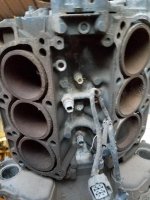dagostino82
Member
Hello,
2003 Honda BF225 with approximately 600-700 hrs. I think.
I noticed water coming from my cowling when I was using the flush port yesterday after a trip. I always flush after trips and almost always use the flush port first and then run the engine with ear muffs. I opened the cowlings and found that the leak was in the middle of the engine behind the VST, so I couldn't see where exactly it was coming from. Tore into the motor and took off the VST. I found a small crack/hole in what I think is the "block". This crack is directly behind the VST. If you can see the picture and tell what this is, am I correct to assume that this motor is done? Probably not worth fixing this on a 14 year old motor right?
Thank you guys!

2003 Honda BF225 with approximately 600-700 hrs. I think.
I noticed water coming from my cowling when I was using the flush port yesterday after a trip. I always flush after trips and almost always use the flush port first and then run the engine with ear muffs. I opened the cowlings and found that the leak was in the middle of the engine behind the VST, so I couldn't see where exactly it was coming from. Tore into the motor and took off the VST. I found a small crack/hole in what I think is the "block". This crack is directly behind the VST. If you can see the picture and tell what this is, am I correct to assume that this motor is done? Probably not worth fixing this on a 14 year old motor right?
Thank you guys!



